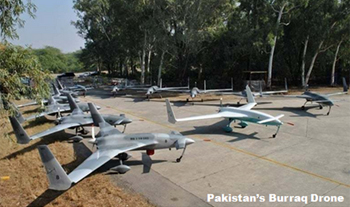INDIAN ARMED FORCES CHIEFS ON
OUR RELENTLESS AND FOCUSED PUBLISHING EFFORTS

SP Guide Publications puts forth a well compiled articulation of issues, pursuits and accomplishments of the Indian Army, over the years

I am confident that SP Guide Publications would continue to inform, inspire and influence.

My compliments to SP Guide Publications for informative and credible reportage on contemporary aerospace issues over the past six decades.
UCAV Race in Subcontinent
 |
By Lt. General P.C. Katoch Former Director General of Information Systems, Indian Army |

Pakistan's army spokesman announced on September 7 that Pakistan’s indigenous Burraq armed drone was used to hit a terrorist compound in Shawai Valley killing three high profile targets. The Burraq was reportedly deployed first time in March to test targeting of both static and moving targets with laser-guided missiles, which was claimed to be a success. Pakistan described the Burraq a force multiplier, which supposedly has all weather capability and pinpoint accuracy being laser guided. Burraq is an unmanned combat aerial vehicle (UCAV) reportedly developed and built by the National Engineering and Scientific Commission (NESCOM) in conjunction the Pakistani air force albeit it is to equip the army as well. The UCAV carries various imagery and motion sensors, and is equipped with a laser guided air-to-surface missile called ‘Barq’. The Burraq UCAV no doubt is a significant milestone for Pakistan but her claim of “indigenous” development is highly dubious. According to Neil Gibson, weapons analyst with IHS Jane’s, despite the claims of Pakistani manufacture, “close analysis of imagery released by Pakistan suggests at least a heavy debt to Chinese systems”, adding that the Burraq “strongly resembles” China’s CH-3 UAV. The 5.1-metre CH-3 has a 200-kilometre range and can carry a 100-kg payload. Pieter Wezeman, senior researcher at SIPRI says “Developing a drone with armed capability is much more difficult than just a reconnaissance one because the reconnaissance one can be built with very basic technology, but integrating weapons is a different level … We're currently treating it as a transfer from China with a 'developed in Pakistan' stamp and a Pakistani name." Elizabeth Quintana from Britain’s Royal United Services Institute too says, "They definitely had help from the Chinese”. Pakistan had been requesting the US repeatedly over the past few years for UCAVs especially with periodic US Predator strikes on Pakistani soil, but the US had not agreed to such requests. So it was but natural that with the China-Pakistan relationship and Pakistani military’s willingness to subcontract Pakistani territory to Beijing that China would help fill this void. China announced in July 2015 she would restrict exports of certain "high performance" drones over concerns they could compromise national security, But then China has never kept her word on these issues given the nuclear proliferation she has indulged in despite official denials. Ni Lexiong, professor at Shanghai University says, “It's possible that China exported the drone to close allies like Pakistan before the ban came into effect”. Interestingly, Major General Asim Bajwa, Pakistan military spokesman, didn't answer calls seeking further details on the development of Burraq and questions sent to China Aerospace Science and Technology received no reply. China's foreign ministry also didn't reply to faxed questions. The fact that Pakistan’s nuclear and missile programs are courtesy China and North Korea are no secret.
The US, Israel, Britain and Nigeria have previously known to have used armed drones in combat. Other countries like France, Iran and UAE too possess UCAVs but there have been no reports of them using it in operations. Global UCAV trade over the past decade has reportedly doubled and is likely to increase with the heightened use of irregular forces, terrorism, insurgencies and asymmetric conflict situations. As per one estimate already some 30 countries are known to be developing or possessing UCAVs. In January 2015, a Chinese CH-3 UCAV had crashed in Nigeria's Borno Province, the heart of the Boko Haram insurgency. Drone attacks by governments, whether on foreign targets or their own citizens, have become increasingly controversial, with the British government in the spotlight for killing two British jihadis in Syria recently and reported US Predator attacks on US soil. India’s indigenous UCAV program (Rustom 2) is in the pipeline though trials are yet to be conducted. It has now been decided to use Kaveri derivative engine (dry engine) without after burner for powering the Indian UCAV. Meanwhile, the Indian government has approved the purchase of 10 Heron TP armed drones from Israel at a cost of US$ 400millon. The military had proposed buying the same UCAVs in 2012 but the proposal didn’t get the support of UPA-2. The project was revived by the Modi government this year. Heron TP is similar to the Predator unmanned aerial vehicles (UAVs) capable of reconnaissance, combat and support roles. Presently, the Indian military operates unarmed Heron and Searcher UAVs for surveillance and intelligence purposes. A team from Israel Aerospace Industries is also in India to explore joint production of drones in India. The Heron TP are equipped with air-to-ground missiles that can carry a payload of 1,000 kg. The project has been given pace and the said drones may be put into service within a year. But India needs to take special note of Pakistan’s Burraq capability because of Pakistani military continuing to follow a state policy of terror and threat of attacks using UAVs by Pakistan based terrorist organizations. Kelley Sayler, fellow at the Centre for a New American Security states, "If states decide that there is a lower threshold for the use of drones particularly in cross-border missions then drones could be quite destabilizing." Such a statement fits Pakistan’s dispensation. India also needs to develop anti-UCAV capability urgently.





